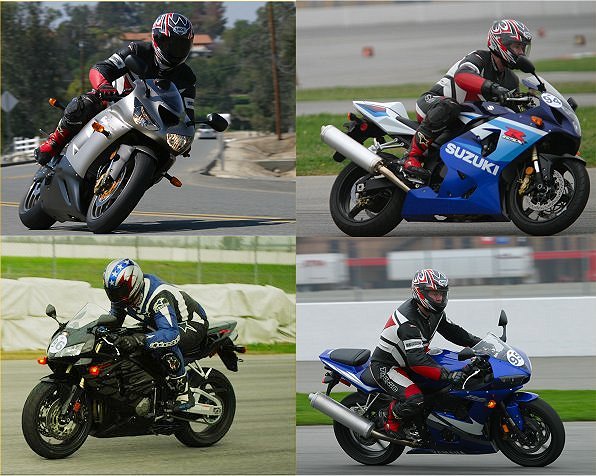
Along with cruisers, sportbikes are nearest and dearest to the hearts of manufacturers. 600s, in particular, are hugely important. The 600 sportbike, in terms of sales volume and profits, can really make or break a manufacturer’s year.
It wasn’t that long ago that 600s received low-end components. Steel frames, cheap brakes, mediocre suspension, etc. Gradually, things changed, and today the 600cc sportbike category has as much, or more, technology thrown at it as any motorcycle category represented in the United States. One of the reasons that the 600cc class of sportbike gets so much attention from manufacturers here in the U.S. is AMA racing. AMA 600 Supersport racing is high profile, “win on Sunday sell on Monday” racing, and the modifications allowed to the stock bikes are minimal. In order to be competitive on the track, the stock bikes have to be darn good to begin with. As a consequence, they are.
This has also become another category where a constant game of “leap frog” is played by the manufacturers. Gone are the days when modifying your bike once every four years was deemed satisfactory. Indeed, significant changes every two years are a must, and the industry is moving toward complete replacement of these motorcycles every two years (witness what Kawasaki has done with its ZX-6R between the 2003 model year and the 2005 model year, for instance). Talk about cut throat competition.
So when you read a “600 shoot-out”, and the author concludes that every single bike in the test is an excellent machine, don’t automatically conclude this is a cop-out designed to avoid offending one or more manufacturers (including advertisers). It is not. It is a fact. Plain and simple. These bikes are all excellent, and represent the best efforts of their capable manufacturers.
In the end, of course, it is our job to determine which bikes are more excellent than the others, and rank them. This is not easy.
While our average reader here at MD does not ride as well as at least two of our testers Willy Ivins and Jeff Whitmer (each an expert level roadracer with many thousands of street miles to boot), he may very well ride as well as the editor, and others who took part in this comparison testing. The faster/more experienced riders really help bring out the fine points of each motorcycle. Their experience and ability to push the bikes near their limits uncover faults that might otherwise go unnoticed.
Nevertheless, the focus has to be on meaningful feedback for the average rider, as well as the experienced, faster rider. The focus also has to be on the street, where these bikes will be ridden by their owners 99% of the time.
This year, we did mix track testing with street testing. Three of the four bikes (excluding the Kawasaki) went to a track day with two of our testers, including Jeff Whitmer and yours truly. The Kawasaki was ridden at the track separately by Mr. Whitmer. Though not ideal, this split testing at the track was necessitated by a minor crash of the Kawasaki, and the repair time involved to bring the bike back up to spec.
All of the bikes were tested back-to-back extensively on the street. As an example, Willy Ivins and I rode each bike through a twisty canyon road, and back to a turn-around point, where we would immediately board another machine and repeat the process. Over and over, followed by discussions to compare and contrast the different strengths and weaknesses of each bike. Time was also spent on each bike droning along the freeway, commuting or otherwise just “putting miles on”. This is necessary to become intimately familiar with the ergonomics and to get a sense of what it is like to live with each machine in the real world.
This year, of course, this test is not entirely fair. It isn’t fair in the sense that three of the four bikes feature 599cc engines, while the fourth one (the Kawasaki ZX-6R) features a 636cc engine. In a category like this, where engine power is extremely important (it is less so in the open class — where you are almost measuring levels of engine overkill), this is a significant advantage for the Kawasaki.
The manufacturers of the 599cc machines are less than happy about being compared with a larger displacement bike. There are reasons why the Kawasaki belongs in this comparison, nonetheless.
Kawasaki does make a 599cc version, called the ZX-6RR, which is available in very limited numbers. This bike is sold for one reason. It is sold so that Kawasaki is eligible for supersport racing. The limited availability of this model, together with its higher price, means that the typical customer will be comparing the four bikes reported on in this test when he visits the showroom. He will not be looking at a ZX-6RR.
Could the larger displacement be a disadvantage for the ZX-6R? It could be. Larger displacement motorcycles typically have performance trade offs associated with additional weight. In particular, additional reciprocating weight in the engine will result in a heavier feeling bike that resists direction changes more than a bike of the same weight with lighter internals.
A larger displacement engine, for example, typically requires a heavier crank shaft. This can be the primary contributor to the perceived increased weight and resistance to turning. Although the ZX-6R belongs in this comparison, we were prepared to criticize its performance if it did not maintain the “flickability” so well known, and loved, by connoisseurs of 600s. As you will see below, and unfortunately for the competition, the Kawasaki felt just as flickable as the other bikes tested, if not more so.
We do not repeat here the technical discussion of each participants’ bike. Take a look at our prior articles/riding impressions for the 2005 Kawasaki ZX-6R; Yamaha YZF-R6; Honda CBR600RR; and the unchanged-for-2005, 2004 Suzuki GSX-R600 for technical details on each model.
Let’s get to our rankings and results.
Fourth Place – Yamaha YZF-R6
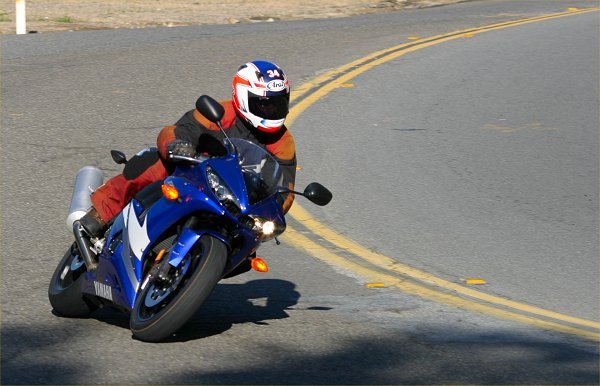
Yamaha’s R6 is rightly considered the bike that revolutionized the 600 sportbike category when it was introduced a few years ago. The “no compromises” approach to performance, with a strong focus on the race track, eventually influenced every other manufacturer. Today, ironically, the R6 is probably the most comfortable bike we tested when ridden for extended distances. The ergonomics are less severe, allowing a rider to sit more upright, with the bars closer to his lap, than much of the competition. The original “no compromises” supersport has become the sport tourer of the category in the sense that your back is a little bit more upright, your hands a bit higher, and your feet a bit more stretched out than they are when riding competitors’ machines.

The R6 still rips in the twisties, however. It changes directions as easily as any machine we tested, and has a bit of a knife-edge feel about it. Advanced riders will appreciate how quick this bike is when transitioning from side-to-side, and the added rigidity of the new-for-2005 upside down front fork.
There are two areas where the R6 gets criticized in comparison with its brethren, however. First of all, although the bike still rips on top and makes plenty of peak horsepower, mid-range performance in this group is less than stellar. Indeed, each of the other bikes pulled harder at real-world rpm levels in the mid-range.
The other problem we encountered is a snatchy fuel injection performance. Coming out of corners, for instance, if you have the throttle completely shut and open it with the bike still on its side, power will come on more suddenly, and less progressively than any other bike in this comparison. While other manufacturers’ fuel injection systems now closely mimic constant velocity carburetors in terms of their transition from closed throttle to open throttle (i.e., they are quite smooth) the R6 seems to have taken a step backwards this year in this regard.

After living with the R6 for a while, we noted that the stock suspension is quite stiff. Still focused on the race track, for the most part, the suspension took quite a bit of fiddling to find a comfortable compromise for our testers on the street. The valving of both the fork and the shock appeared to be in the ball park, but the spring rates are too high for your average street rider. Although the R6 felt stable on the street, we experienced some minor headshake on the track.
As noted in our earlier test, the performance of the front brake of the R6 is outstanding, providing excellent power and feel. Likewise, we had no complaints about the transmission performance or the clutch.
While rumors swirl of an all-new R6 appearing next year, the 2005 R6 needs some tweaking of the fuel injection to bring it in line with the performance of the other bikes in this category. Given this fact, this still might be the motorcycle of choice for track day addicts and racers, who will routinely replace the stock exhaust system and install a power commander or other engine management system that will override the stock fuel injection settings.
Second Place (Tie) – Suzuki GSX-R600
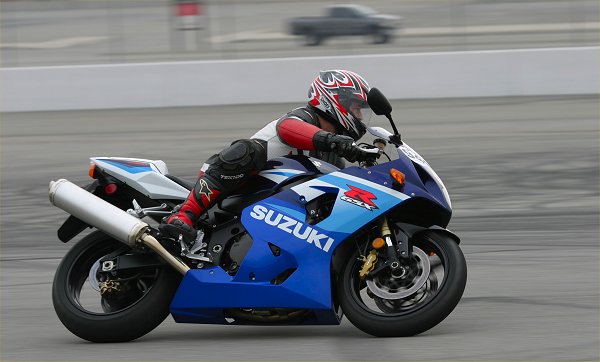
We hate ties. Declaring a tie is too easy. It takes guts to rank the bikes without declaring any ties, whatsoever. Too bad. We tried.

The 2005 Suzuki GSX-R600 is an outstanding motorcycle. It was probably the best 600 available last year, and returns for 2005 with no significant changes. Nevertheless, it still is a very competitive, and satisfying machine.
One of our testers declared the GSX-R600 the most balanced, and easiest to ride, machine in this group out of the box. The suspension is outstanding, the brakes predictable, and powerful, and the engine provides all the mid-range power you could ask for on the street.

This bike is reasonably comfortable, with decent wind protection for this category of motorcycle. Again, the GSX-R600 used to be a bit of a torture rack, but with every other manufacturer moving toward a more extreme riding position, this bike is now a reasonably comfortable mount for a 600 supersport.
This bike really doesn’t do anything terribly wrong. The instrumentation is thorough, and legible. The transmission slick, and the aforesaid suspension more than competent.
It loses out in the outright power department this year to virtually every other bike at the top end of the tachometer. While this is largely unnoticed on the street, where the strong mid-range pulls you around with authority, on the race track the bike feels a bit flat up top. Both the Honda and the Kawasaki have it beat in the mid-range as well. In the case of the Honda, not by much.
Handling is fluid and precise, leading to the confidence our testers all felt when cranking the GSX-R600 through corners. The bike was pretty stable , and none of us experienced any head shake.
The GSX-R600 is also just plain fun to ride. The intake and exhaust note emitted by this bike is unmatched by any other in this category. It sounds mean and aggressive, and this sound really adds to the enjoyment of riding the GSX-R600.
Second Place (tie) – Honda CBR600RR
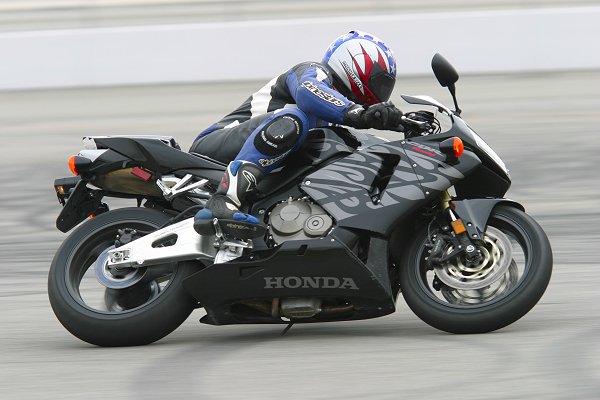

We have to start by pointing out that the 2005 Honda CBR600RR has the strongest 599cc engine we have ever evaluated. It feels stronger than both the Yamaha and the Suzuki virtually everywhere. The power comes on smoothly and builds progressively, but quickly. This bike pulls the front wheel up off the tarmac in first gear when you are hard on the throttle, whether you want it to come up or not. It will also, occasionally, float the front wheel in second gear without any assistance from the clutch. Very strong, indeed.
Fuel injection on the CBR600RR is good, but not quite as good as the fuel injection on the Suzuki, and the Kawasaki sets a new standard for fuel injection performance (as we discuss below). Nevertheless, throttle response is generally clean and predictable with the Honda, and certainly superior to the Yamaha R6.

The Honda has more than just motor going for it. With an upside down fork this year, and roughly 20 pounds lopped off its dry weight, the CBR600RR feels much more responsive. The weight loss improved acceleration and braking (radial brakes are outstanding — probably, the best in this class), and it has a new-found agility in the twisties.
Suspension is a bit track focused (that means stiff), but can be dialed in for the street to most rider’s satisfaction. Opinion was divided on how much feedback/confidence our riders felt through the tires and the chassis of the Honda. One of our testers lamented a lack of feedback from the front tire, while other testers disagreed.
Where the Honda falls behind the competitors, to some extent, is in street comfort. Honda has gone for more aggressive ergonomics, and the 600RR returns with a seat that makes you beg for mercy on long rides.
The low windscreen is virtually useless on the street, but it doesn’t obscure the view of the excellent instruments, like Kawasaki’s does.
First Place – Kawasaki ZX-6R
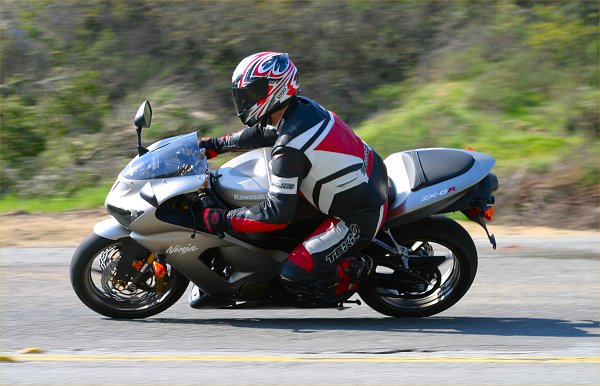

We start again with the motor. The 2005 ZX-6R is the horsepower king in this class. The bike puts that extra 37cc to good use, delivering smooth, predictable and sometimes fierce acceleration. The fuel injection performance on this bike is the best ever. Seamless throttle response with no hiccups or lurches.
That extra displacement does not carry with it any handling compromises. The ZX-6R is one of the quickest turning bikes in this group, and feels as light or lighter than the competition. The dry weight of this bike falls in the middle of this group.

The handling of the ZX-6R is balanced right on the edge between quick-but-stable handling and instability. The bars will give you a polite wiggle as you wheelie out of corners in second gear, but we never experienced anything approaching serious headshake. Overall, the bike was reasonably stable, and its handling was always predictable and precise.
Stock suspension settings were in the ball park, and some fiddling brought both the fork and the shock to a point where everyone seemed happy, particularly on the street. When Whitmer rode the 6R on the race track, he felt both ends were too soft (then again, Whitmer outweighs your “target customer” by 50 pounds, or so). Serious riders/racers might benefit from a switch to straight rate springs, dumping the progressive springs offered on the stock machine.
Ergonomics are reasonably comfortable (better than last year’s ZX-6R), but the windshield is low enough to be virtually useless on the street, and partially obscures the instrumentation. This latter problem isn’t really a problem, because the instrumentation (notably, the tachometer) is not really legible except while sitting in your garage revving the bike at a standstill.
Our test unit did not have stellar brakes. Whether the rotors were glazed, or the pads were shot, or some combination thereof, none of our testers were impressed with the ZX-6R’s brakes, although they were reasonably powerful. This contrasts with the impression at the race track intro we reported on earlier, where the brakes were praised for both power and feel.
All these complaints are really nits we have picked, however, when you view the ZX-6R as a whole. That sweet fuel injection, awesome power, solid suspension package and predictable, light handling all combine to create our winner of this comparison test.
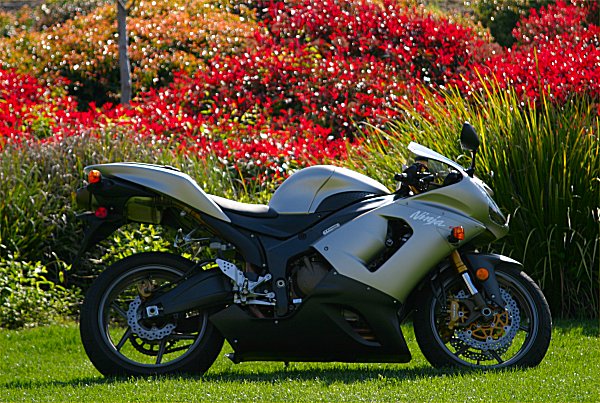
Conclusion
The consumer wins again this year. Each manufacturer continues to push the envelope to provide the best middleweight sportbike package available. The Kawasaki takes home first place this year, but the game of leap frog will likely continue . . .
The 2005 Kawasaki ZX-6R carries a US MSRP of $8,699. You can find more info at the Kawasaki Web Site
The 2005 Suzuki GSX-R600 carries a US MSRP of $8,299, while the 2005 Honda CBR600RR has a US MSRP of $8,999. For more info, check out the Suzuki Web Site and the Honda Web Site.
The 2005 Yamaha R6 carries a US MSRP of $8,399. More info can be found at the Yamaha web site.





